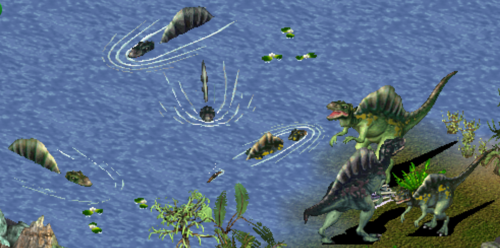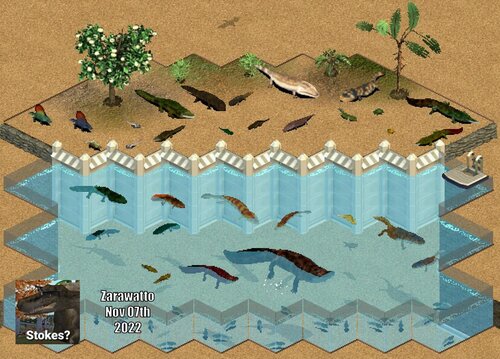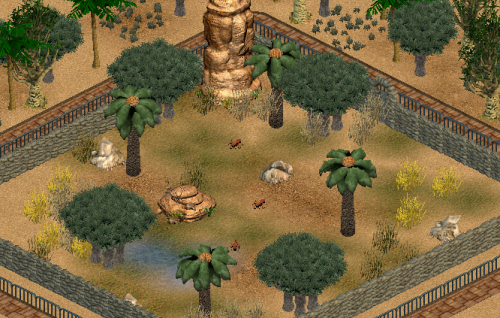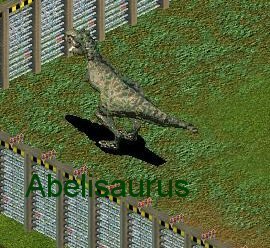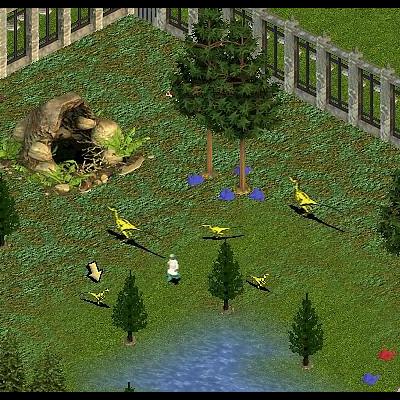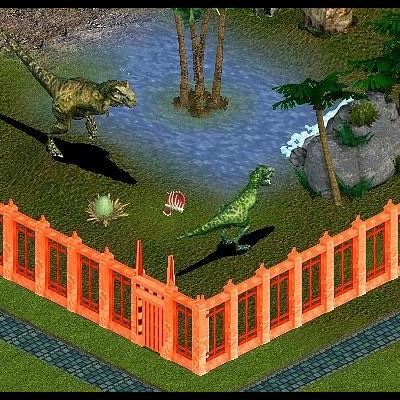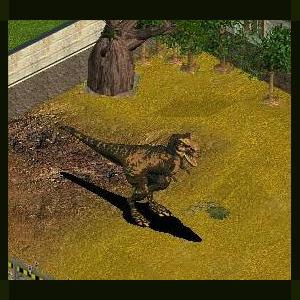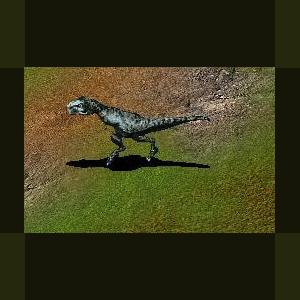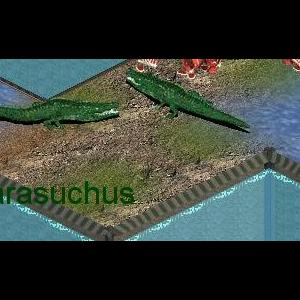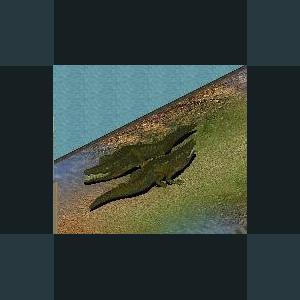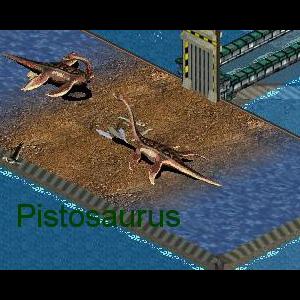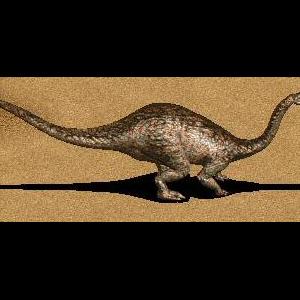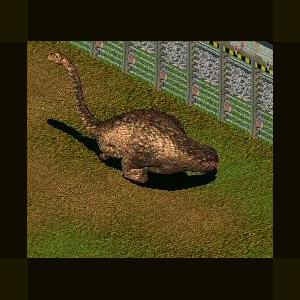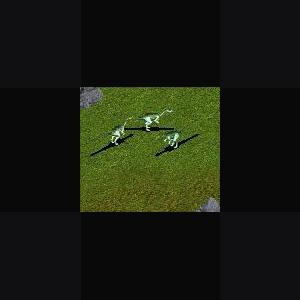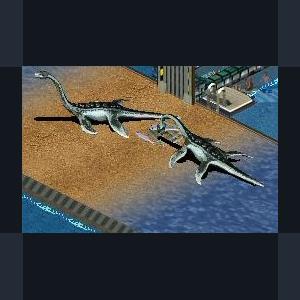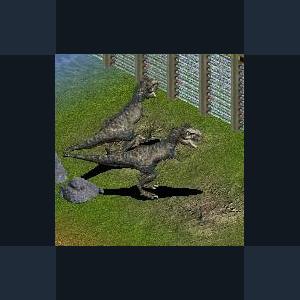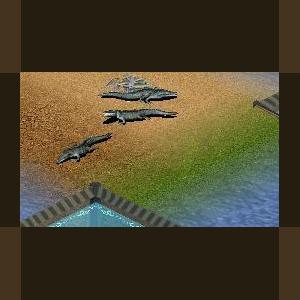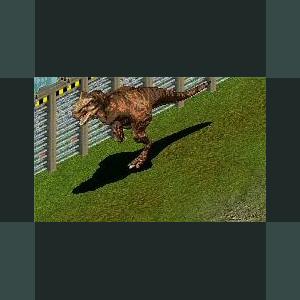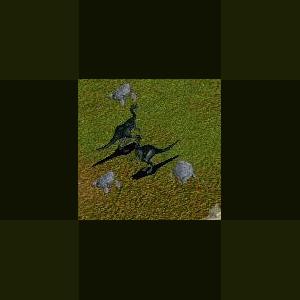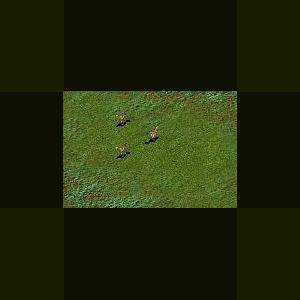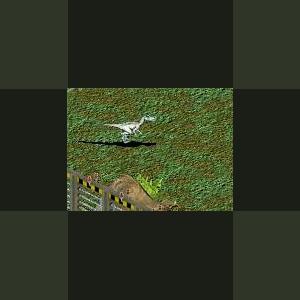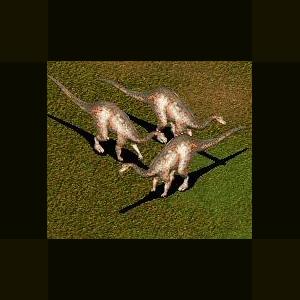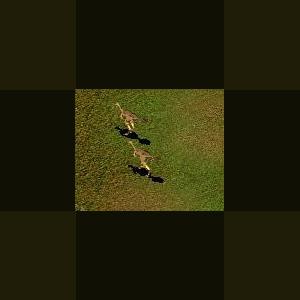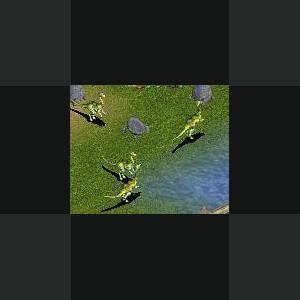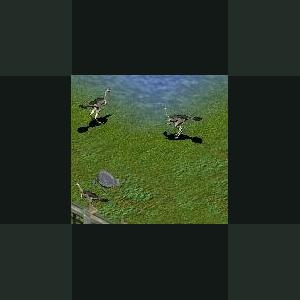Dinosaurs
Creatures from another age
241 files
-
Swimming Spinosaurus by Jymn
By Cricket
Would you look at that!
The Spinosaurus at your zoo has finally caught up with modern paleontological consensus and learned to swim. Nice work, guys. They're so happy they've got a derpy new land animation that plays occasionally (made from the fence-zap animation with all the electric shock taken out)
Also they're dimorphic: the ladies are dark crocodile-colours and the babies are dark with yellow spots--like baby crocodiles. The boys just have a slight color change to the inside of the mouth.
Available as a hack or as a new animal. The exhibit requirements are similar to the Combined Realism Hack but you may need to make a few adjustments.
Right now there aren't any 'special' animations in the water like snapping or thrashing. Maybe they'll learn some tricks over the summer...
134 downloads
Updated
-
Toadally Batrocious Land Invaders (Extinct Amphibians Pack)
By Zarawatto
This pack is a Halloween gift for all of you!
~~ IMPORTANT NOTE!!! ~~
Some animals use message texts and images contained in the following files: Borsato's ui99ztd + LANG--ZBorsato.dll in order to see all animal eras in the purchase menu & description window properly. However, even without them, all files should work right.
If you don't have them and wanna know how it works, you may find it here:
https://zootekphoenix.com/forums/topic/11248-borsato-project/page/21/#comment-317858
~~ Content List ~~
Hynerpeton North America. Aquatic. Devonian.
Ichthyostega North America. Aquatic. Devonian.
Proterogyrinus North America. Coniferous Forest. Carboniferous.
Eryops North America. Coniferous Forest. Carboniferous.
Platyhystrix North America. Desert. Permian.
Diploceraspis North America. Desert. Permian.
Uralerpeton Asia. Desert. Permian.
Prionosuchus South America. Coniferous Forest. Permian.
Gerrothorax Europe. Aquatic. Triassic.
Sclerothorax Europe. Aquatic. Triassic.
Metoposaurus Europe. Aquatic. Triassic.
Anaschisma North America. Aquatic. Triassic.
Antarctosuchus Antarctica. Decidous Forest. Triassic.
Mastodonsaurus Eurasia. Aquatic. Triassic.
Siderops Australia. Rainforest. Jurassic.
Beelzebufo Madagascar. Rainforest. Cretaceous.
*Bonus Items*
Tiktaalik North America. Aquatic. Devonian. Early access animal. First release date: Oct 10th, 2022.
-> Tiktaalik previous version must be erased from your /dlupdate folder before installing this pack <-
Swimming Tadpoles Neutral exhibit & tank placeable scenery item!
-> A .txt file with the credits & a compatibility guide.
Enjoy!
184 downloads
Updated
-
Protosolpuga by Serpyderpy
By Serpyderpy
Protosolpuga is an extinct species of solifugae known only from a single specimen that was discovered in Mazon Creek, Illinois, USA. While somewhat bigger than their real life size, these wonderful little creepy crawlies will make a nice addition to your paleozoic zoos!
83 downloads
0 comments
Updated
-
Abelisaurus by Moondawg
By Savannahjan
Abelisaurus ("Abel's lizard") is a genus of abelisaurid theropod dinosaur from the Late Cretaceous Period of what is now South America.
The generic name recognizes Roberto Abel as the discoverer of the specimen and former director of the provincial Museum of Cipolletti in Argentina, where the specimen is housed. It also incorporates the Greek sauros, meaning 'lizard'. There is one named species, A. comahuensis, which honors the Comahue region of Argentina, where the fossil was found. Both genus and species were named and described by Argentine paleontologists Jose Bonaparte and Fernando Novas in 1985, who placed it in the newly-created family Abelisauridae.
Many other abelisaurids have since been discovered, including extremely complete specimens of Aucasaurus, Carnotaurus and Majungasaurus. Some scientists place Abelisaurus as a basal abelisaurid, outside the subfamily Carnotaurinae. Others are less certain of its position.Abelisaurids share some skull features with the unrelated carcharodontosaurids and, since Abelisaurus is known only from a skull, future discoveries may show that this genus was in fact a carcharodontosaurid. However, this is thought unlikely.
The one known fossil skull of Abelisaurus is incomplete, especially on the right side. It is also missing most of the palate (roof of the mouth). Despite the missing pieces, it is over 85 centimeters (33 inches) long. Although there are no bony crests or horns, like those found in some other abelisaurids, such as Carnotaurus, rough ridges on the snout and above the eyes might have supported some kind of crest made out of keratin, which wouldn't have become fossilized. There are also very large fenestrae (window-like openings) in the skull, which are found in many dinosaurs and reduce skull weight
Abelisaurus is one of the many dinosaurs that have been discovered in Patagonia. It was originally described as coming from the Allen Formation but subsequent research proved the remains were actually found in the older Anacleto Formation (part of the Neuquén Group) of Rio Negro Province, Argentina. The Anacleto is a geologic formation in South America, dating from the early Campanian stage of the Late Cretaceous Period, between 83 and 80 million years ago.
95 downloads
Updated
-
Variraptor by JohnT
By Admin Uploader
As a cousin of the Velociraptor, your zoo guests will enjoy this colorful but deadly animal.
You must have either DD or CC to use this dinosaur.
87 downloads
0 comments
Updated
-
Rainforest T-Rex by JohnT
By Admin Uploader
The T-Rex loves plenty of fresh meat, and needs the strongest fence to hold it. This Rainforest Tyrannosaurus Rex uses the same graphics as the in-game T-Rex, but with a change in habitat and object preferences, as well as different animal info. Since this T-Rex links directly to the graphics of the in-game T-Rex, you must have either DD or CC to use it. The in-game T-Rex will still be available in addition to this T-Rex.
78 downloads
- dinosaur
- rainforest
- (and 1 more)
0 comments
Updated
-
Tarbosaurus by Ghirin
By Guest
Tarbosaurus Author: Ghirin
Tarbosaurus ("Terrible Lizard") was a large tyrannosaurid from the Cretaceous period in Asia. This dinosaur was very similar to the North American Tyrannosaurs rex and some paleontologists consider it to be a species of Tyrannosaur, naming it Tyrannosaurus bataar.
*Inspired by the Zoo Tycoon Brains Trust at the Zoo Tycoon Evolved Forum.*
265 downloads
Submitted
-
Siamotyrannus by Moondawg
By Guest
Siamotyrannus isanensis (meaning "Siamese Tyrant") was a carnosaur from the Early Cretaceous. Its fossils, the pelvis and vertebrae were found in Thailand. . As evidenced by its name, it was originally thought to be a tyrannosauroid, though it is quite small at 6.5m in length. It has also been suggested that it may be an allosaurid or sinraptorid.
* Inspired by the Zoo Tek Brains Trust
167 downloads
0 comments
Updated
-
Parasuchus by Moondawg
By Guest
Parasuchus was a genus of several crocodile-like semi-aquatic animals that lived in the Late Triassic, specifically the earlier Late Carnian period. The reptiles lived throughout Europe, North America, and North Africa.
190 downloads
0 comments
Updated
-
DinoCroc by Moondawg
By Guest
DinoCroc
Dinocroc is a 2004 horror film about a prehistoric carnivore, Sarcosuchus imperator. It is resurrected in a genetics laboratory after being mixed with a modern day crocodile, resulting in a hybrid monstrosity that has a lot in common with the Spinosaurus. It escaped the lab in a run-of-the-mill American town, and begins devouring the residents.
305 downloads
Updated
-
Pistosaurus by Moondawg
By Guest
Pistosaurus longaevus is an extinct genus of aquatic sauropterygian reptile belonging to the plesiosaur order.
PISTOSAURUS
(pronounced PIST-oh-SAWR-us) Pistosaurus was a nothosaur, a reptile with flipper-like limbs that lived both on land and in the water. It was about 10 feet (3 m) long with a very long neck, four long, paddle-shaped flippers, a streamlined body, and many sharp, pointed teeth in long jaws. Fossils have been found in France and Germany. It lived during the mid-Triassic period. It was not dinosaur
227 downloads
0 comments
Updated
-
Aegyptosaurus by Moondawg
By Guest
Aegyptosaurus meaning 'Egypt’s lizard', where it was discovered is a genus of dinosaur believed to have lived in what is now Africa, around 95 million years ago, during the mid- and late-Cretaceous Period.
351 downloads
0 comments
Updated
-
Barapasaurus by Moondawg
By Guest
Barapasaurus is curious because it is the earliest known sauropod, dating from the early Jurassic Period — more precisely the Toarcian age, about 189.6 to 176.5 million years ago. This is evident in the unspecialized nature of its form. Later sauropods like Brachiosaurus developed their own ecological niche and feeding strategies. However, Barapasaurus was something of an "all-purpose" dinosaur. For example, later sauropods developed hollow vertebrae, as a weight-saving measure. Barapasaurus vertebrae, on the other hand, were almost solid, with only the earliest hints of hollowing. (See also: Camarasaurus.)
Despite its early place in dinosaur history, Barapasaurus reached a length of about 18 metres (60 feet), and weighed about 48 tones (53 tons). Its height to the hip was approximately 5.5 metres (18 feet).
Like all sauropods, Barapasaurus was a herbivore. However, no skull has yet been recovered and so its exact diet has not been determined. A few lone teeth are known but not sufficient to make judgments on diet.
Barapasaurus is also important because, although its remains were found in India, it is very similar to other samples found in East Africa. From this we can conclude that during the early Jurassic period, these two land masses were still connected or at least only recently divorced.
Barapasaurus is included in Vulcanodontidae rather than Cetiosauridae, another family in Sauropoda. This classification is unconfirmed since insufficient work has been done on the skeletons. The description is justified by the narrow sacrum (a boxlike structure of the hip), which is a characteristic of vulcanodontids. However, the dorsal vertebrae display features shared with Cetiosauridae, such as a high neural arch above the vertebral foramen.
Currently the only known species is the original B. tagorsi.
The first bones of Barapasaurus were recovered in India in 1960. However, it was not until 1975 that this recovery was made the type specimen, and the official description published by Jain, Kutty, Roy-Chowdhury and Chatterjee of Calcutta.
Since then, five additional skeletons have been recovered from the Godavari Valley in southern India. However, none of these included the skull or feet. The remainder of the skeleton is known, so it is theoretically the best-known of the early Jurassic sauropods. Unfortunately, little work has yet been published regarding these discoveries.
296 downloads
0 comments
Updated
-
Podokesaurus by Moondawg
By Guest
The only fossils of Podokesaurus holyokensis (the full name given by Talbot) were recovered in 1911 by Mount Holyoke College professor of geology and geography, Mignon Talbot from a boulder near to the college. It was formally described that year based on a poorly preserved, incomplete fossil skeleton.
This fossil evidence suggests that it may not be a distinct genus but in fact a species of Coelophysis, standing 1 m (3 ft) long and 0.3 m (1 ft) high, and weighing 4 kg (10 lb). The matter is complicated because all the original fossil evidence for Podokesaurus holyokensis was destroyed in a fire and only casts remain in The Division of Paleontology at the American Museum of Natural History, New York.
115 downloads
0 comments
Updated
-
Muraenosaurus by Moondawg
By Guest
Muraenosaurus ('moray eel lizard') is an extinct genus of sauropterygian reptile belonging to the plesiosaur order. It lived in Late Jurassic Europe, and grew to 30 feet (8 m) long. Half of its length was its neck, which consisted of 44 vertebrae. Its skull was small.
240 downloads
0 comments
Updated
-
Nanotyrannus by Moondawg
By Guest
Nanotyrannus ("tiny tyrant") is a genus of tyrannosaurid dinosaur, and is possibly a
juvenile specimen of Tyrannosaurus. Represented only by a small skull it was discovered by Charles W. Gilmore in 1942 and described in 1946 as a
specimen of Gorgosaurus lancensis (now known as Albertosaurus).In 1988, the
specimen was re-described by Robert T. Bakker, Phil Currie, and Michael Williams,
the late curator of paleontology at the Cleveland Museum of Natural History, where
the original specimen was housed and is currently on display. Initial research indicated
that the skull bones were fused, and that it therefore represented an adult specimen.
In light of this, Bakker and colleagues assigned the skull to a new genus, which they
named Nanotyrannus for its apparently small size.However, subsequent work has cast
doubt on this, and some paleontologists no longer consider it a valid genus--since the
fossil was a contemporary of Tyrannosaurus rex, many paleontologists now believe it to
be a juvenile T.rex, especially since the discovery in 2001 of new Nanotyrannus specimen,
nicknamed "Jane." The original Nanotyrannus specimen is estimated to have been around
17 feet (5.2 meters) long when it died.
In 2001, a more complete juvenile tyrannosaur ("Jane"),
belonging to the same species as the original Nanotyrannus specimen, was uncovered.
In 2005, a conference on tyrannosaurs focused on the issues of Nanotyrannus validity
brought about by the discovery of the Jane specimen, was held at the Burpee Museum of
Natural History. Several paleontologists, such as Phil Currie and Donald M. Henderson,
saw the discovery of Jane as a confirmation that Nanotyrannus was a juvenile T. rex or
closely related species.Peter Larson, on the other hand, continued to support a
separate genus for Nanotyrannus.The actual scientific study of Jane, set to be
published by Bakker, Larson, and Currie, may help determine whether Nanotyrannus is a
valid genus, whether it simply represents a juvenile T. rex, or whether it is a new
species of a previously identified genus of tyrannosaur.
Bakker has stated he believes Nanotyrannus hunted in packs. Teeth from multiple Nanotyrannus have been found in the bones of herbivorous dinosaurs.
In 2008, Nanotyrannus was featured in the second episode of Jurassic Fight Club, a pseudo-documentary about prehistoric predators.[8] The episode dismissed the ongoing scientific debate on the validity of the Nanotyrannus genus, with the producers preferring instead to present a speculative battle between two juvenile Tyrannosaurus and one Nanotyrannus (which was possibly a juvenile Tyrannosaurus). The episode depicted both genera as having pronated hands (hands with downward or backward-facing palms), something tyrannosaurids could not do.[9] The episode relied heavily on speculation to determine who would be the victor in the battle between the similar (or possibly synonymous) genera. Some television reviewers felt the battles depicted in the series were over-hyped and remarked negatively on the producers and experts' speculation about what the animals were thinking.[10]
190 downloads
Updated
-
Bernissartia by Moondawg
By Guest
Bernissartia is one of the smallest crocodylians that ever lived. It resembled modern species and was probably semi-aquatic. It had long, pointed teeth at the front of the jaws would have been of use in catching fish, while the broad and flat teeth at the back of its jaws would have facilitated crushing hard food, such as shellfish and possibly bones. It lived during the early Cretaceous in modern day England and Belgium.
270 downloads
0 comments
Updated
-
Gorgosaurus by Moondawg
By Guest
Like most known tyrannosaurids, Gorgosaurus was a multi-ton bipedal predator equipped with dozens of large, sharp teeth; it also bore tiny two-fingered forelimbs typical of its close relatives. Although relatively large for a theropod, Gorgosaurus was much smaller than its more famous relative Tyrannosaurus.
Gorgosaurus (pronounced GOR-go-SAWR-us; meaning "fierce lizard") is a genus of tyrannosaurid theropod dinosaur that lived in western North America during the Late Cretaceous Period, between about 77 and 74 million years ago. Fossil remains have been found in the Canadian province of Alberta and possibly the U.S. state of Montana. Paleontologists recognize only the type species, G. libratus, although other species have been erroneously referred to the genus.
Like most known tyrannosaurids, Gorgosaurus was a bipedal predator weighing more than a metric ton as an adult; dozens of large, sharp teeth lined its jaws, while its two-fingered forelimbs were comparatively small. Gorgosaurus was most closely related to Albertosaurus, and more distantly related to the larger Tyrannosaurus. Gorgosaurus and Albertosaurus are extremely similar, distinguished mainly by subtle differences in the teeth and skull bones. Some experts consider G. libratus to be a species of Albertosaurus; this would make Gorgosaurus a junior synonym of that genus.
Gorgosaurus lived in a lush floodplain environment along the edge of an inland sea. An apex predator, it was at the top of the food chain, preying upon abundant ceratopsids and hadrosaurs. In some areas, Gorgosaurus coexisted with another tyrannosaurid, Daspletosaurus. Though these animals were roughly the same size, there is some evidence of niche differentiation between the two. Gorgosaurus is the best-represented tyrannosaurid in the fossil record, known from dozens of specimens. These plentiful remains have allowed scientists to investigate its ontogeny, life history and other aspects of its biology.
291 downloads
0 comments
Updated
-
Garudimimus by Moondawg
By Guest
Garudimimus ("Garuda mimic") is a basal member of Ornithomimosauria, known from single specimen discovered from Upper Cretaceous sediments of Mongolia.
Previously it was thought that this primitive member of Ornithomimosauria possessed a horn at the top of the skull. However, recent studies have shown that this "horn" was simply a misplaced skull bone. In 1981, Rinchen Barsbold placed it in its own family, Garudimimidae.
Inspired by the Zoo Tek Brains Trust
145 downloads
0 comments
Updated
-
Microraptor by Moondawg
By Guest
Microraptor had two sets of wings, on both its fore- and hind legs. The long feathers on the legs of Microraptor were true flight feathers as seen in modern birds, with asymmetrical vanes on the arm, leg, and tail feathers. As in bird wings, Microraptor had both primary (anchored to the hand) and secondary (anchored to the arm) flight feathers. This standard wing pattern was mirrored on the hind legs, with flight feathers anchored to the upper foot bones as well as the upper and lower leg. It had been proposed by Chinese scientists that the animal glided, and probably lived in trees, pointing to the fact that wings anchored to the feet of Microraptor would have hindered their ability to run on the ground, and suggest that all primitive dromaeosaurids may have been arboreal.
Sankar Chatterjee determined in 2005 that, in order for the creature to glide or fly, the wings must have been split-level (like a biplane) and not overlayed (like a dragonfly), and that the latter posture would have been anatomically impossible. Using this biplane model, Chatterjee was able to calculate possible methods of gliding, and determined that Microraptor most likely employed a phugoid style of gliding--launching itself from a perch, the animal would have swooped downward in a deep 'U' shaped curve and then lifted again to land on another tree. The feathers not directly employed in the biplane wing structure, like those on the tibia and the tail, could have been used to control drag and alter the flight path, trajectory, etc. The orientation of the hind wings would also have helped the animal control its gliding flight. Chatterjee also used computer algorithms that test animal flight capacity to test whether or not Microraptor was capable of true, powered flight, in addition to passive gliding. The resulting data showed that Microraptor did have the requirements to sustain level powered flight, so it is theoretically possible that the animal flew on occasion in addition to gliding.
Some paleontologists have suggested that feathered dinosaurs used their wings to parachute from trees, possibly in order to attack or ambush prey on the ground, as a precursor to gliding or true flight. In their 2007 study, Chatterjee and Templin tested this hypothesis as well, and found that the combined wing surface of Microraptor was too narrow to successfully parachute to the ground without injury from any significant height. However, the authors did leave open the possibility that Microraptor could have parachuted short distances, as between closely spaced tree branches.
Chatterjee and Templin also ruled out the possibility of a ground-based takeoff. Microraptor lacked the necessary adaptations in its shoulder joint to lift its front wings high enough vertically to generate lift from the ground, and the authors argued that a ground-based takeoff would have damaged flight feathers on the feet. This leaves only the possibility of launching from an elevated perch, and the authors noted that even modern birds do not need to use excess power when launching from trees, but use the downward-swooping technique they found in Microraptor.
The unique wing arrangement found in Microraptor raised the question of its importance to the origin of flight in modern birds--did avian flight go through a four-winged stage, or were four-winged gliders like Microraptor an evolutionary side-branch that did not leave descendants? As early as 1915, some scientists had argued that the evolution of bird flight may have gone through a four-winged (or tetrapteryx) stage. Chatterjee and Templin did not take a strong stance on this possibility, noting that both a conventional interpretation and a tetrapteryx stage are equally possible. However, based on the presence of unusually long leg feathers in various feathered dinosaurs, Archaeopteryx, and some modern birds such as raptors, as well as the discovery of Pedopenna (another dinosaur with long primary feathers on its feet), the authors argued that the current body of evidence, both from morphology and phylogeny, suggests that bird flight did shift at some point from shared limb dominance to front-limb dominance, and that all modern birds may have evolved from four-winged ancestors, or at least ancestors with unusually long leg feathers relative to the modern configuration.
The naming of Microraptor is controversial, because of the unusual circumstances of its first description. The first specimen to be described was part of a chimeric specimen , a patchwork of unrelated feathered dinosaur species assembled from multiple specimens in China and smuggled to the USA for sale. After the forgery was revealed by Xu Xing of Beijing's Institute of Vertebrate Paleontology and Paleoanthropology, Storrs L. Olson, curator of birds in the National Museum of Natural History of the Smithsonian Institution, published a description of the tail in an obscure journal, giving it the name Archaeoraptor liaoningensis in an attempt to remove the name from the paleornithological record by assigning it to the part least likely to be a bird. However, Xu had discovered the remainder of the specimen from which the tail had been taken and published a description of it later that year, giving it the name Microraptor zhaoianus.
Since the two names designate the same individual as the type specimen, Microraptor zhaoianus is a junior objective synonym of Archaeoraptor liaoningensis and the latter, if valid, has priority. So, according to some interpretations of the International Code of Zoological Nomenclature, the valid name for this dinosaur probably is Archaeoraptor liaoningensis Olson 2000. However, there is some doubt whether Olson in fact succeeded in meeting all the formal requirements for establishing a new taxon. Most paleontologists are unwilling to use the name Archaeoraptor regardless of the precise legal status of the name. This is firstly because that name is strongly associated with the fraud and the National Geographic scandal and secondly because they view Olson's use of the name as attempted nomenclatural sabotage and do not want to support it. The name Microraptor zhaoianus Xu et al., 2000 has therefore almost attained universal currency.
293 downloads
0 comments
Updated
-
Utahraptor by Moondawg
By Guest
Utahraptor (meaning "Utah's predator") is the largest known member of the theropod dinosaur family
Dromaeosauridae, and dates from the upper Barremian stage of the Early Cretaceous period (132-119 million years ago).
Like other dromaeosaurids, Utahraptor had a huge curved claw on the second toe that could grow to 23 centimetres (9.1 in) long. The animal may have grasped its prey with its forelimbs while kicking with its hindlimbs. Recent tests on reconstructions of the smaller Velociraptor suggest that claws of this type were used for stabbing or suffocating its prey, not slashing into their hide.Up to 6.5 m (21 ft) long, 2 m (6.6 ft) tall, and 700 kg (1,500 lb) in weight, Utahraptor would have been a formidable predator.
Updated by Cricket on April 5, 2012:
Removed space from name
Removed extra verbiage
348 downloads
Updated
-
Vulcanodon by Moondawg
By Guest
Vulcanodon (meaning "volcano tooth") was a relatively small, early sauropod dinosaur genus from the Early Jurassic.
It was about 6.5 meters (20 feet) long. Vulcanodon ate plants and lived in southern Africa. The type species, V. karibaensis, was formally described by Michael A. Raath of the University of the Witwatersrand, Johannesburg, in 1972.
It was originally believed to be a prosauropod because of the knife shaped teeth found near its fossils, which fit in with the idea that prosauropods were omnivorous, but scientists now know that the teeth belonged to an unidentified theropod that scavenged on the Vulcanodon's carcass.
152 downloads
0 comments
Updated
-
Bambiraptor by Moondawg
By Guest
The Bambiraptor skeleton was discovered in 1995 by 14-year-old fossil hunter Wes Linster, who was looking for dinosaur bones with his parents near Glacier National Park in Montana. Linster told Time Magazine that he uncovered the skeleton on a tall hill and was amazed at his discovery. "I bolted down the hill to get my mom because I knew I shouldn't be messing with it", he said. The bones that Linster discovered on that hilltop led to the excavation of a skeleton that was approximately 95 percent complete. Because of its completeness Florida Paleontology Institute Director Martin Shugar compared it to the 'Rosetta Stone' that enabled archaeologists to translate Egyptian hieroglyphics. Yale paleontologist John Ostrom, who reintroduced the theory of bird evolution from dinosaurs after his 1964 discovery of Deinonychus in Wyoming, agreed, calling the specimen a "jewel", and telling reporters that the completeness and undistorted qualities of the bones should help scientists further understand the dinosaur-bird link. The specimen is currently housed at the American Museum of Natural History, New York.
During the conference where Bambiraptor was first introduced, the dinosaur reconstruction specialist Brian Cooley portrayed Bambiraptor as having feathers, despite the fact that no feathers were found with the fossil itself. His decision was influenced by the fact that because Bambiraptor within a cladistic analysis was a member of a group, Paraves, that contained feathered true birds and that was the sister taxon of Oviraptorosauria, a group that also had feathered forms (e.g. Caudipteryx), Bambiraptor most likely had feathers too due to phylogenetic bracketing. Most paleontologists support Cooley's view, and subsequent discoveries confirmed that small dromaeosaurid dinosaurs like Bambiraptor were fully covered in feathers.
Research done at Lamar State College in Orange, Texas has indicated that Bambiraptor may have had opposable front claws and a forelimb maneuverability that could reach its mouth. This would have given the animal the ability to "hold" food in its front limbs and place it in its mouth, in a similar manner to some modern-day small mammals.
Bambiraptor skull in the Oxford University Museum of Natural History.Bambiraptor had a brain size in the lower range of modern birds. Because of its enlarged cerebellum, which may indicate higher agility and higher intelligence than other dromaeosaurs, David A. Burnham has hypothesized that Bambiraptor feinbergi may have been arboreal. Life in the trees may have required evolutionary pressure that resulted in a larger brain. Burnham also offers an alternative hypothesis that a larger brain could be selected for as a result of hunting more agile prey items such as lizards and mammals. Bambiraptor had the largest brain for its size of any dinosaur yet discovered, although the brain size may be due to its age, because juvenile animals tend to have larger brain-to-body ratios compared to adults. It also had very long arms and a well-developed wishbone.
233 downloads
0 comments
Updated
-
Compsognathus by Moondawg
By Guest
Compsognathus (pronounced kompsos"elegant", "refined" or "dainty", and gnathos"jaw") was a small, bipedal, carnivorous theropod dinosaur.
The animal was the size of a turkey and lived around 150 million years ago, the early Tithonian stage of the late Jurassic Period, in what is now Europe.
Paleontologists have found two well-preserved fossils, one in Germany in the 1850s and the second in France more than a century later.
Many popular presentations still describe Compsognathus as a "chicken-sized" dinosaur because of the small size of the German specimen, which is now believed to be a juvenile form of the larger French specimen. Compsognathus is one of the few dinosaurs for which the diet is known with certainty: the remains of small, agile lizards are preserved in the bellies of both specimens. Teeth discovered in Portugal may be further fossil remains of the genus.
Although not recognized as such at the time of its discovery, Compsognathus is the first dinosaur known from a reasonably complete skeleton. Today, C. longipes is the only recognized species, although the larger specimen discovered in France in the 1970s was once thought to belong to a separate species, C. corallestris. Until the 1980s and 1990s, Compsognathus was the smallest known dinosaur and the closest supposed relative of the early bird Archaeopteryx. Thus, the genus is one of the few dinosaur genera to be well known outside of paleontological circles.
273 downloads
0 comments
Updated
-
Protoavis by Moondawg
By Guest
Protoavis is claimed to have been a 35 cm tall bird that lived in what is now Texas, USA,
between 225 and 210 million years ago. Though it existed far earlier than Archaeopteryx,
its skeletal structure is allegedly more bird-like. Protoavis has been reconstructed as
a carnivorous bird that had teeth on the tip of its jaws and eyes located at the front of
the skull, suggesting a nocturnal or crepuscular lifestyle. The fossil bones are too bad
ly preserved to allow an estimate of flying ability; although reconstructions usually
show feathers (see link below), judging from thorough study of the fossil material there
is no indication that these were present (Paul, 2002; Witmer, 2002).
However, this description of Protoavis assumes that Protoavis actually existed and,
if so, that it has been reconstructed correctly. Almost all paleontologists doubt that
Protoavis is a bird, or even a good species, because of the circumstances of its
discovery, and unconvincing avian synapomorphies in its fragmentary material.
When they were found at a Dockum Formation quarry in the Texas panhandle in 1984,
in a sedimentary strata of a Triassic river delta, the fossils were a jumbled cache of
disarticulated dinosaur and other bones that may reflect an incident of mass mortality
following a flash flood.
The discoverer, Sankar Chatterjee of Texas Tech University, was convinced that some of
these crushed bones belonged to two individuals - one old, one young - of the same
species. However, only a few parts were found, primarily a skull and some limb bones
which moreover do not well agree in their proportions respective to each other, and this
has led many to believe that the Protoavis fossil is chimeric, made up of more than one
organism: the pieces of skull appear like those of a coelurosaur, while most parts of
the limb skeleton suggest affinities to ceratosaurs and at least some vertebrae are most
similar to those of Megalancosaurus[2], which despite what its name may suggest is not a
dinosaur but rather an avicephalan diapsid:
"Everywhere one turns; the very fossils ascribed thereto challenge the validity of
Protoavis. The most parsimonious conclusion to be inferred from these data is that
Chatterjee's contentious find is nothing more than a chimera, a morass of long-dead
archosaurs."
If it really existed, Protoavis would raise interesting questions about when birds
began to diverge from the dinosaurs, but until better evidence is produced, the
animal's status currently remains uncertain. Furthermore, paleobiogeography suggests
that birds did not colonize the Americas until the Cretaceous; the most primitive
lineages of unequivocal birds found to date are all Eurasian. Certainly, the fossils
are most parsimoniously attributed to primitive dinosaurian and other reptiles as
outlined above. However, coelurosaurs and ceratosaurs are in any case not too distantly
related to the ancestors of birds and in some aspects of the skeleton not unlike them,
explaining how their fossils could be mistaken as avian; Archaeopteryx itself was
initially believed to be a small theropod dinosaur. Zhonghe Zhou sums up the matter:
"[Protoavis] has neither been widely accepted nor seriously considered as a Triassic
bird [... Witmer], who has examined the material and is one of the few workers to
have seriously considered Chatterjee’s proposal, argued that the avian status of
P. texensis is probably not as clear as generally portrayed by Chatterjee, and
further recommended minimization of the role that Protoavis plays in the discussion
of avian ancestry."
Sometimes it is claimed that Protoavis is a refutation of the hypothesis that birds
evolved from dinosaurs. But this is not true; the only consequence would be to push
back the point of divergence further back in time and possibly cause the dromaeosaurs to
be included in the bird clade. Note that at the time when these claims were originally
made, the affiliation of birds and maniraptoran theropods which today is well-supported
and generally accepted by most ornithologists was much more contentious; most Mesozoic
birds have only been discovered since then. Note also that Chatterjee himself has used
Protoavis to support a close relationship between dinosaurs and birds.
"As there remains no compelling data to support the avian status of Protoavis or
taxonomic validity thereof, it seems mystifying that the matter should be so contentious.
The author very much agrees with Chiappe in arguing that at present, Protoavis is i
rrelevant to the phylogenetic reconstruction of Aves. While further material from the
Dockum beds may vindicate this peculiar archosaur, for the time being, the case for
Protoavis is non-existent
168 downloads
0 comments
Updated

